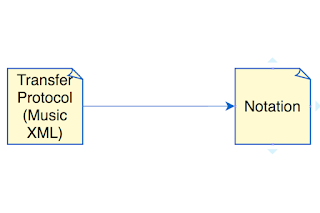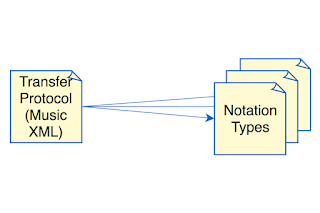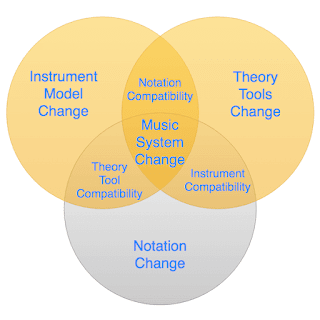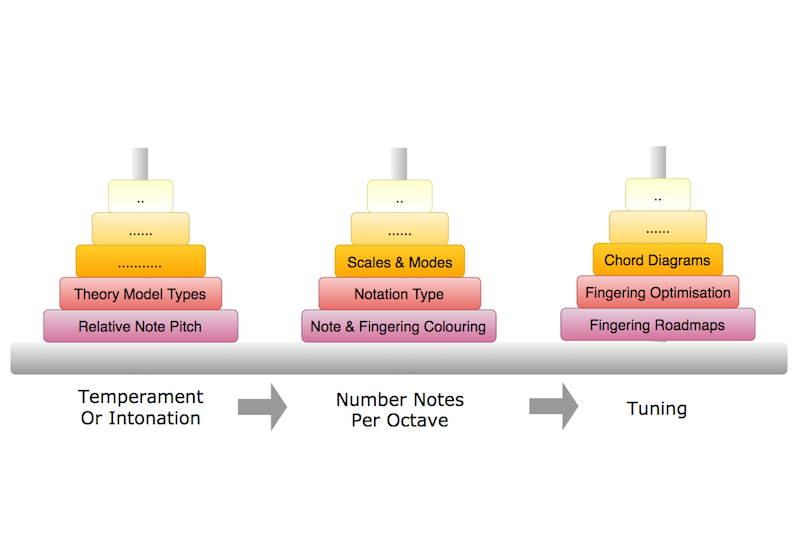The banner screenshot above hints at possibilities never before seen in an online music environment - music notation directly driving a wholly configurable variety of instrument models and theory tools in an entirely graphical setting. It doesn't take long to figure out that the music system being represented is based on equal temperament. What, though, of all the other world music systems - of which there are many?
This post examines the music systems underlying notations: the musical configurations and semantic or semiotics (meanings or intentions) notation glyphs or symbols seek to convey.
Music System Diversity
MusicXML is perhaps the most expressive of exchange file formats. Capable of representing entire multipart orchestral scores, it's reputation has earned it integration into web standards under the aegis of the W3C.
Though increasingly capable of representing music notations from other musical cultures (for example Arabic and Turkish makam), in most people's mind's MusicXML is tied to the 12-tone equal temperament (12-EDO or 12-TET) western or classical music notation system. There is pressure to integrate other music systems, but don't hold your breath.
Stripped of the more recent (and -in an age of responsive and algorithmic placement- pointless) screen positioning information, MusicXML specifies a score's structural characteristics. Amongst others: voice, octave, duration, note name (pitch) and note type. Critically, the note appearance is not specified.
This is important, as it on the one hand allows various fonts to be applied, and on the other allows a degree of latitude in the type of notation used. In effect MusicXML invites limited notation 'misuse'.. Let me list a few examples:
Equally, certain microtonal notation systems (for example Sagittal) are capable of use with equal temperament music.
All that is required are:
Notation The Driver. Reads L to R.
Notation
MusicXML
1 : many
The relationship between exchange file and notation is demonstrably one-to-many. In recognising that, dear heart, we open up new avenues of exploration.
Big, brave, open-source, non-profit, community-provisioned, cross-cultural and batshit crazy. → Like, share, back-link, pin, tweet and mail. Hashtags? For the crowdfunding: #VisualFutureOfMusic. For the future live platform: #WorldMusicInstrumentsAndTheory. Or simply register as a potential crowdfunder..
Transnotation
To recap, western notation can be -and indeed is- used to represent certain forms of just intoned systems. Equally, microtonal notationsystems such as Sagittal, conceived to represent just intoned music, can be used to represent conventional equal tempered pieces.
To be absolutely clear, we are not merely talking of subtly differentiated glyph sets (as between, say, Gonville and Emmenthaler), but the disambiguation of, and compatibility mapping between fundamentally different musical notations.
We are talking of the ability to represent a piece of music using notations based on one of a number of different underlying music systems.
The concept described here is known as 'Transnotation', and though not yet (to my knowledge) implemented in any online notation system, is long established amongst ethnomusicologists.
My gut feeling is that this -to all intents and purposes simple- capability is the key to unlocking a wave of cross-cultural or comparative musicological interest. Moreover, it's consequent implementation, though in a comprehensively 'music visualization' sense manpower-intensive, is decidedly not rocket science.
We might also (logically) infer that a given score can be represented by more than one type of exchange file. Indeed, here we can begin to think of compatibility mappings between exchange files.
As always, to avoid duplication, one should always seek mappings at the lowest possible level in any dependency tree. Our dependency tree stretches from underlying music systems over their semantic or semiotic representations to the formalities of exchange files to actual notations.
Clearly, mappings such as these are not just between various notation families, but effectively to music systems and hence cultures. If these could be formalized, might they not unlock some powerful practical applications?
Let's take a stab at illustrating this slightly confusing topic in one simple visual model. If we think of equal temperament and just intoned music systems as 'orthogonal' to each other, we might nevertheless find 'best-fit' pitch mappings between the two.
We show just two from many potential mappings. Other, perhaps experimental notations could be represented by additional tetrahedrons with an edge common with the underlying notation. The basis for a future animation?
Incidentally, similar results might alternatively (and more accurately) be found by directly overlaying the pitch graphs for the two systems.
For the meantime, we should simply be aware of notation mappings as a means of transitioning between:
Though those known and applied are limited in number, such mappings open a number of avenues for musical exploration.. The challenge, of course, is not just to indicate that a different pitch system is referred to, but -especially in the case of just intonations- to indicate which (possibly regional) derivative is intended.
At the end of the day, however, there is likely to be a simple and elegant solution. My own preferred hack is to describe the problem, and to allow the old wetware to work on it while sleeping.
Why Explore Music System Diversity?
Music notations in all their forms remain a surprisingly fertile and active area of interest and study among artists and musicians.
While many have western classical music as context, it's probably fair to assume the similar levels of interest across all music cultures. Moreover, we humans can prove very adaptable. The use of music notations in contexts other than originally intended is no exception.
Often, the easiest way to learn something new is to relate it back to the known. Say you have two notation systems, one designed for equal temperament, the other for just intonation. A specific note may have a wholly different representation within each notation system, yet be so close in pitch that the representation is all but irrelevant.
This is a possible mapping: find enough and you have a general purpose bridge between the two systems. Uses?
In earlier posts, amongst others, we identified the following two configuration or control levels:
.. and of the flexibility boost they bring. Here they are illustrated:
Here we see two types of configuration change in action: the defaults, driven both by the musical source (here MusicXML) and user's environmental settings, and any directly user-controlled and propagated 'what-if' type changes.
Freedom of navigation between compatible music systems seems likely to serve these ends. For the rest, we will be able to see at a glance where differences lie and why they are rendered incompatible.
Those used to the 'western' 12-tone equal temperament can be truly surprised to learn of the many other music systems in use worldwide. Whether surveyed by ethnicity, region, country, religion or underlying music system, there is vast diversity of musical convention, style - and tonal subtlety. For the most part, the latter is largely lost on ears accustomed only to western music.
Swapping perspectives for a moment, having your musical culture ignored, misunderstood or even disparaged is for many -along with language, food or customs- just another challenge in an increasingly multicultural society.
Music Systems In The Learning Process
The concept of transnotation is intimately bound to the way musical symbols are used to represent intent.
Having got this far, let's go just a little deeper, and see if we can identify how learning is affected by music system -and especially symbolism. Keep in mind: we are not talking specific notations or symbolism here, but the notion of musical intent.
Music Systems In The Learning Process
Goal
Means
Concrete Example
Transsemiotic mappings
Semiotic interworking.
Semantic or semiotic compatibility within same exchange format (source), semantic 'meta-knowledge'. Pan- and music-system-generic symbolism.
Extending Horizons
Microtonal Tunings & Regional Prefs
Expressing fine-grain regional differences in tuning practice.
Musical flexibility
Accommodation of global change.
Accommodation of key change or transposition, and instruments in other than noted keys..
Stylistic disambiguation
Elements of style. Innovation
Semiotics of fine-motor, stylistic intent and their disambiguation. Symbol innovation.
External mappings
Fingering, chord etc representations
Semiotics of pitch-finger position mappings, including chord representation
Detailed glyph-semiotics mappings
Semiotics catalogue.
Survey semiotics of pitch, voice, dynamics etc. What exists? Existing meanings. Gap analysis.
Initial Orientation
Identify applicable music systems
Desired semiotics across time signatures, pitch, dynamics etc.
Music System Application Area
Culture, instrumentation, conventions
What do we want to communicate?
Where There's A Will, There's A Way
Finally, mappings between notations dedicated to different music systems have the potential to open many cultural doors. How might we accelerate their discovery? Here some tentative thoughts.
Keywords
online music learning,
online music lessons
distance music learning,
distance music lessons
remote music lessons,
remote music learning
p2p music lessons,
p2p music learning
music visualisation
music visualization
musical instrument models
interactive music instrument models
music theory tools
musical theory
p2p music interworking
p2p musical interworking
comparative musicology
ethnomusicology
world music
international music
folk music
traditional music
P2P musical interworking,
Peer-to-peer musical interworking
WebGL, Web3D,
WebVR, WebAR
Virtual Reality,
Augmented or Mixed Reality
Artificial Intelligence,
Machine Learning
Scalar Vector Graphics,
SVG
3D Cascading Style Sheets,
CSS3D
X3Dom,
XML3D
ANY: Music System ◦ Score ◦ Voice ◦ Instrument Or Theory Tool Config ◦
World Music's DIVERSITY and Data Visualisation's EXPRESSIVE POWER collide. A galaxy of INTERACTIVE, SCORE-DRIVEN instrument model and theory tool animations is born.
Entirely Graphical Toolset Supporting World Music Teaching & Learning Via Video Chat ◦ Paradigm Change ◦ Music Visualization Greenfield ◦ Crowd Funding In Ramp-Up ◦ Please Share
Featured Post
All Posts (*** = Recap)
- User Environment - Preferences and Population
- Comparative Musicology & Ethnomusicology
- Music Visualisation - a Roadmap to Virtuosity ***
- A Musical Instrument Web Repository
- Toolset Supported Learning Via Video Chat
- Key Platform Features ***
- Platform Aspirations
- Aggregator Platform vs Soundslice
- Music, Machine Learning & Artificial Intelligence
- World Music Visualisations And The 3D Web
- Cultivating Theory Tool Diversity
- Cultivating Instrumental Diversity
- Cultivating Notation Diversity
- Cultivating Music System Diversity
- One URL To Animate Them All And In The Browser Bind Them ***
- Music Visualisation: Platform Overview
- Music Visualisation: Challenges
- Music Visualisation: The Key To Structure
- Music Visualisation: Motivation ***
- Music Visualisation: Key Concepts ***
- Music Visualisation: Social Value
- Music Visualisation: Prototype
- Music Visualisation: Catalysts
- Music Visualisation: Platform Principles
- Music Visualisation: Here Be Dragons
- Music Visualisation: Potential
- Music Visualisation: The Experimental Edge
- Music Visualisation: Business Models
- Music Visualisation: Technical Details
- Music Visualisation: (Anti-)Social Environment
- Music Visualisation: Arts, Crafts, Heritage
- Music Visualisation: Politics
- Music Visualisation: Benefits ***
- PROJECT SEEKS SPONSORS
- Consistent Colour Propagation
- Orientation: Genre-Specific Workflows
- P2P Teacher-Student Controls
- Musical Modelling
- Social Media Integration
- Platform Provisioning In Overview
- Generic to Specific Modelling: A Closer Look
- Notation, Standardisation and Web
- Communication: Emotional vs Technical
- Musical Storytelling
- Product-Market Fit
- Monthly Challenge
- World Music Visualisations and Virtual Reality
- World Music Visualisations: Paradigm Change?
- How Does It All Work Together?
- Off-the-Shelf Animations: Musical Uses
- MVC vs Data Driven
- A Reusable Visualisation Framework
- What IS Music Visualisation?
- Questions Music Visualisations Might Answer
- Google Group for World Music Visualisation
- Instrument Visualization: Fingering Controls
- Static, Active, Interactive, Timeline-Interactive
- Visualising Instrument Evolution
- Unique Social Value (USV)
- Instrument Modelling: Lute Family
- Person-to-Person ('P2P') Music Teaching
- Alternative Music Visualizer Scenarios
- Music Visualisation: Why a platform, not just an app?
- Music, Dance and Identity: Empowerment vs Exploitation
- Why No Classification System For Music Theory?
- Musical Heritage, Copyright and Culture
- Visualisation Aggregator Platform - Musical Immersion
- Instrument Models - Complete Configuration Freedom
- Diversity is Health, Contentment is Wealth
- Politics & Provisioning Mechanisms of World Music Learning
- Technology, Tribes, Future and Fallout
- Rule-Based vs Data-Driven Notation
© Copyright 2015 The Visual Future of Music. Designed by Bloggertheme9 | Distributed By Gooyaabi Templates. Powered by Blogger.









Comments, questions and (especially) critique welcome.